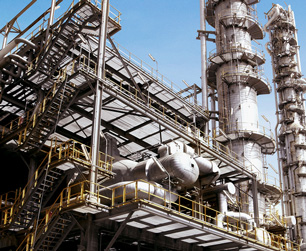Epichlorohydrin (ECH)
| EPA Maximum Contaminant Level Goal (MCLG) |
zero |

Epichlorohydrin (ECH) is an organic compound used in manufacturing glycerol, epoxy resins and other industrial products. It can theoretically enter drinking water through residue on flocculating agents used to remove sediment during water treatment. According to the EPA:
During manufacturing of the epichlorohydrin-based polymeric coagulant aids, a small amount of epichlorohydrin may remain in the coagulant aids as an impurity. When these coagulant aids are used in water treatment, there is a potential for residual epichlorohydrin to be introduced in water. Finished water may also contain epichlorohydrin because of raw water contamination from other uses of epichlorohydrin and because of leaching from epichlorohydrin based components and materials used in drinking water treatment, storage and distribution.
Health Effects of ECH
Acute symptoms, according to the EPA, include "skin irritation [and] detrimental effects on liver, kidneys [and] central nervous system." The agency also warns that epichlorohydrin is a potential carcinogen and can lead to stomach problems:
Some people who drink water containing high levels of epichlorohydrin over a long period of time could experience stomach problems and may have an increased risk of getting cancer.
Water Treatment for ECH
According to the EPA, epichlorohydrin is difficult to detect and has no proven means of treatment. Instead, its use is limited at the source of contamination:
The Phase II rule, which includes the regulation for epichlorohydrin, limits the allowable residual epichlorohydrin (an impurity) in the polymeric coagulant aids, to 0.01 percent by weight and the dosage of polymeric coagulant aid which can be added to raw water to remove particulates, to 20 parts per million (ppm).
Sources: EPA (1), EPA (2), WHO, Photo: WikiMedia, author: Secl
Site Index
Filtration Systems
- Aeration for Iron & Sulfide
- Backwashing Filters
(whole house & well units)
- Chlorine & Chemical Injectors
- Countertop Water Filters
- Garden Hose Filters
- Reverse Osmosis, Residential
- Reverse Osmosis, Commercial
- Shower Filters
- Specialty Filters
- Ultraviolet Systems
- Undersink Filters
- Water Softeners
- Whole House Filters
Cartridges
Parts
- Replacement Parts
- Faucets
- Filter Media
- Fittings
- Housings
- O-rings
- Pumps
- Pura UV
- R.O. Parts
- R.O. Tanks
- R.O. Booster Pump
- VIQUA UV